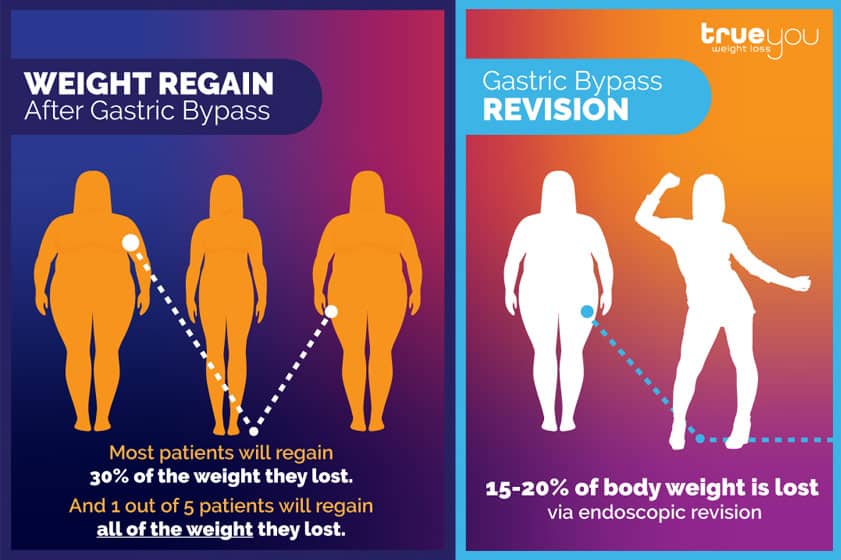Life comes with very few assurances. Even the promises of a “guaranteed fix” sometimes don’t live up to the billing. This can be particularly true when it comes to the human body.
Gaining weight back after being on a diet is something many people are familiar with. The up and down weight swings are one reason people become discouraged with dieting alone as a solution to obesity. The option of weight loss surgery can seem like a perfect solution in this case. It would be easy to think that permanently changing the size of your stomach would fix weight gain problems forever.
The fact is, nearly one in five people who undergo weight loss surgery end up gaining back their excess body weight within the first several years after surgery. To find out how this happens, we need to take a look at how weight loss surgery works.
Bariatric surgery is a term used to cover a number of different procedures and surgeries that affect the digestive tract. These surgeries are intended for people who have a body mass index (BMI) over 35 and at least one other co-morbidity such as diabetes or heart disease. All of these options have the same basic goal—to help you consume fewer calories.
Each of these surgeries in their own way helps to either restrict the amount of food you can eat or slow it down as it passes through your stomach. Below is a quick overview of the various types of bariatric surgery.
There are many more types of weight loss surgeries, but these are the most common, and other surgeries are often a variation on one of these three types of procedure. These surgeries can either be performed laparoscopically where the surgeon works remotely with the aid of special tools inserted through small incisions in your abdomen, or they can be performed as traditional abdominal surgery.
Nearly everyone who goes through a bariatric procedure will experience a dramatic initial weight loss. This is partly due to the restrictive diet you will be placed on to allow your new stomach to heal. Even after you are back on solid foods, which can be weeks or months after surgery, you are going to be on a diet that may only allow you to consume 300-600 calories a day.
The human body has a marvelous ability to adapt to changes, and trimming down the size of your stomach is not a guaranteed fix for weight loss. Though the size of your new stomach is dramatically smaller after surgery, over time your stomach pouch can stretch.
Stretching of the gastric pouch happens for two reasons. It can occur naturally as your body attempts to adapt to the new arrangement of your digestive tract, or it can happen as a result of over-eating. Gastric bypass patients need to maintain a very strict diet of tiny meals. Failing to keep to this diet can lead to eating more food than your stomach can handle. Doing this repeatedly will eventually cause the gastric pouch to stretch.
Once your new stomach has stretched, the restrictive effect of your surgery will no longer be as effective. If you are relying on the feeling of fullness to tell you when to stop eating, you will slowly begin taking in more and more food as your stomach stretches. Over time, this will lead to post-surgery weight regain, something that can feel devastating if you have paid a considerable amount of money and changed your diet and lifestyle in the hopes you would finally find the freedom you were looking for from excess weight.
If you are in the unfortunate position of having regained weight after a bariatric procedure, don’t fret. You have options to help you stop the weight regain from continuing. If you are finding that, as was the case before your surgery, exercise, and dietary efforts are not enough to keep the extra pounds off, then you might be a candidate for bariatric revision surgery.
Just like gastric bypass, a bariatric revision surgery is not something that happens by surprise. The bariatric surgeon who performed your original obesity surgery will be working with you during your follow up appointments to see if you are tolerating the initial surgery well. If your doctor sees signs of inadequate weight loss, he or she may start to wonder if there has been a change to the size of your gastric pouch. If X-rays of your gastrointestinal tract confirm this suspicion, you may be a candidate for a surgical revision.
Bariatric surgery works by shrinking the size of the stomach, and most bariatric revision options are designed to return the size of your gastric pouch to the intended post-surgery size. The surgical options available to you are going to depend on the weight loss surgery you had to begin with, the weight loss results you are looking to achieve.

There are revision procedures for other types of bariatric surgery. Sleeve gastrectomies can be addressed by a sleeve revision that restores the intended size of your gastric sleeve. Gastric bypass revision has several options for revision due to the extremely common nature of that initial procedure. The most common bariatric revision procedures include:
Like the initial surgery itself, considering any of these bariatric revisions will involve weighing the complication rate of the procedure, your particular weight loss goals, and other factors like your base metabolic rate and physical condition.
If it sounds daunting to undergo the expense and strain of surgical revision, you may be relieved to learn there may be options that can restore your stomach pouch to its intended size without going under the knife. As an alternative to traditional or even laparoscopic surgery that is used in gastric bypass procedures, some forms of gastric bypass revision can be performed endoscopically.
Endoscopy is a procedure where a small, flexible tube is inserted through the mouth and down the esophagus and into the stomach. This tube can be fitted with a camera to allow a trained bariatric surgeon to evaluate the condition and size of your stomach. Endoscopy is performed under twilight anesthesia, and it is usually performed as an outpatient procedure rather than requiring a hospital stay.
Endoscopic gastric revision, known as Transoral Outlet Reduction (TORe), allows a surgeon to insert a suturing device into your stomach to stitch together your stomach pouch from the inside. This effectively reverses the stretching to the pouch that has occurred since your original surgery. This type of gastric bypass revision has the benefit of a lowered complication rate compared to other revision surgeries. Unlike duodenal switches or Roux limb lengthening that involve manipulating your intestines, endoscopic bariatric revision has a decreased likelihood of leakage or other serious post-surgery complications.
Gastric bypass revision results in smaller weight losses compared to bariatric surgery. This is partly due to people having less weight to lose, with only 20-35% of patients regaining 50% of their excess weight within 10 years. Results will vary depending on the type of bariatric revision you choose, but it is possible to lose between 20-55% of your excess weight that has been gained back after gastric bypass. Some patients lose nearly all of their excess weight.
Gastric bypass surgery is famous for patients experiencing triple digit weight losses in the first year after surgery. It is not uncommon for people to lose up to 70% of their excess body weight, making the promise of a new life after surgery seem appealing.
Gastric bypass revision, on the other hand, has seemingly more modest results, with patients often only losing 10-15% of their body weight. These results need to be taken in context, however. Unlike your original surgery, the amount of excess weight you need to lose will likely be smaller if your weight regain has been identified and monitored in follow-up appointments with your surgeon.
Bariatric revision surgery is only relevant for those who have previously had some form of bariatric surgery. In gastric bypass, for example, the gastric pouch can stretch out over time and become less effective at controlling calorie intake. Through revision surgery, a doctor can return the gastric pouch to its original size and enable the patient to continue losing weight.
Several types of bariatric surgery, including gastric bypass and sleeve gastrectomy, have decades of medical evidence that demonstrate their effectiveness at helping patients lose weight and keep it off. Nevertheless, 20-35% of patients end up regaining up to 50% of the weight they initially lost after surgery, often because of an enlarged gastric pouch. Patients who have the endoscopic gastric revision procedure at True You can lose between 10-20% of their total body weight and will be able to keep it off for years.
At True You, gastric revision surgery is performed endoscopically. This means that, via an endoscope fed down the throat, the doctor can return the gastric pouch to its original size and shape all without the need for incisions. The endoscope has special tools mounted on the end that allows the doctor to make the revisions from inside the stomach. The fact that no incisions are needed means that the procedure is safer than regular surgery and takes far less time to recover.
The endoscopic gastric revision procedure at True You is performed in an outpatient setting and typically takes around 30 minutes to complete under mild sedation. Recovery is usually a brief process while you wake up from the sedation, and you are able to go home afterwards.
In gastric bypass surgery, a small pouch is created from a portion of the stomach, and this pouch is then attached directly to the small intestine. This is done in order to limit the physical amount of food that can be consumed in one sitting in order to promote an ongoing calorie deficit. In a sleeve gastrectomy, a banana-shaped “sleeve” is formed from the stomach instead of the small pouch. The other major difference is that the sleeve gastrectomy is just a reduction in stomach volume; the stomach remains connected to the small intestine as normal.
A very similar version of the procedure used on a prior gastric bypass surgery can also be used on a prior gastric sleeve surgery. Just as a gastric pouch can become enlarged over time, a gastric sleeve can become stretched and allow more food to be ingested. At True You, we use the same endoscopic tool to perform the procedure safely and quickly in an outpatient setting. The only difference in the procedure is that the whole sleeve is returned to its normal size instead of the small gastric pouch.
Because our state-of-the-art procedures are performed via endoscope, the risk of major complications is less than 1%; the lack of incisions means there is a much smaller risk of bleeding or infection or some kind of injury to the stomach. Most patients at True You experience mild symptoms like indigestion, nausea, or a feeling of abdominal pressure or pain.
Recovery time after the endoscopic procedure is brief. You’ll be able to return home usually within a few hours of the procedure, and most people will be able to return to work and other activities after 2-3 days of rest. Dietitians at True You will provide recommended modifications for diet and physical activity level; following these recommendations will be an important part of continuing to lose weight and maintain weight loss over the long term.
At True You Weight Loss, we have the experience needed to handle your bariatric revision. Dr. Christopher McGowan has performed more than 15,000 endoscopic procedures to date, utilizing the specific skills required by endoscopy on a daily basis.
If you find yourself in the position of having regained excess body weight after gastric bypass surgery, know there are options available to help you return to your desired weight. Request a consultation today to see what True You Weight Loss can do to help you get back on the path to finding the freedom you have been searching for.

Dr. Christopher McGowan, MD, a leader in endobariatrics, specializes in non-surgical obesity treatments and is triple-board-certified in Internal Medicine, Gastroenterology, and Obesity Medicine. Renowned for pioneering endoscopic sleeve gastroplasty (ESG) with over 2,000 procedures, his global influence and research contributions define him as a top expert.



